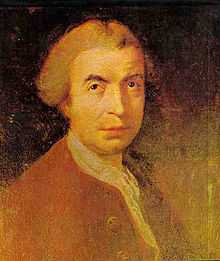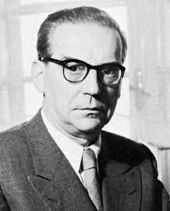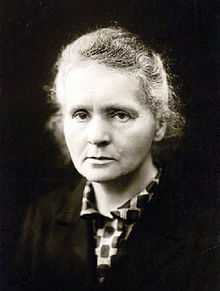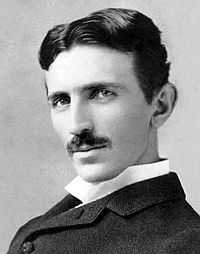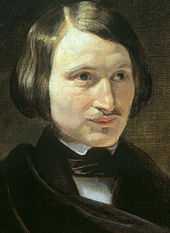Slavs
| |||||||||||||||||||||||||||||||
| Total population | |||||||||||||||||||||||||||||||
|---|---|---|---|---|---|---|---|---|---|---|---|---|---|---|---|---|---|---|---|---|---|---|---|---|---|---|---|---|---|---|---|
| 350 million [1] | |||||||||||||||||||||||||||||||
| Regions with significant populations | |||||||||||||||||||||||||||||||
| 150,000,000[2][3][4][5] | |||||||||||||||||||||||||||||||
| 57,393,000[6] | |||||||||||||||||||||||||||||||
| 57,000,000[7][8] | |||||||||||||||||||||||||||||||
| 12,000,000[9][10] | |||||||||||||||||||||||||||||||
| 12,000,000[11] | |||||||||||||||||||||||||||||||
| 10,000,000[12][13] | |||||||||||||||||||||||||||||||
| 10,000,000 | |||||||||||||||||||||||||||||||
| 8,000,000[14][15][16] | |||||||||||||||||||||||||||||||
| 5,401,000[17] | |||||||||||||||||||||||||||||||
| 2,500,000[18] | |||||||||||||||||||||||||||||||
| 2,200,000[19] | |||||||||||||||||||||||||||||||
| 2,800,000 | |||||||||||||||||||||||||||||||
|
750,000 Slavs without a state: | |||||||||||||||||||||||||||||||
| Rusyns | 1,200,000[20] | ||||||||||||||||||||||||||||||
| Moravians | 631,000[21] | ||||||||||||||||||||||||||||||
| Kashubians | 233,000[22] | ||||||||||||||||||||||||||||||
| Sorbs | 65,000[23][24] | ||||||||||||||||||||||||||||||
| Gorani | 60,000[25] | ||||||||||||||||||||||||||||||
| Lemkos | 11,000[26] | ||||||||||||||||||||||||||||||
| Yugoslavs | 415,000[27] | ||||||||||||||||||||||||||||||
| Czechoslovaks | 341,000[28] | ||||||||||||||||||||||||||||||
| Slavs | 143,000[29] | ||||||||||||||||||||||||||||||
| Kociewiacy | 3,000[30] | ||||||||||||||||||||||||||||||
| Gorals | 3,000[31] | ||||||||||||||||||||||||||||||
| Greaterpoles | 2,000[32] | ||||||||||||||||||||||||||||||
| Languages | |||||||||||||||||||||||||||||||
|
Slavic languages (West, East, South) | |||||||||||||||||||||||||||||||
| Religion | |||||||||||||||||||||||||||||||
|
Christianity Minority Atheism and Islam (mostly Sunni) | |||||||||||||||||||||||||||||||
The Slavs are an Indo-European ethno-linguistic group living in Central Europe, Eastern Europe, Southeast Europe, North Asia and Central Asia, who speak the Indo-European Slavic languages, and share, to varying degrees, certain cultural traits and historical backgrounds. From the early 6th century they spread to inhabit most of Central and Eastern Europe and Southeast Europe. Over half of Europe's territory is inhabited by Slavic-speaking communities. Present-day Slavic people are classified into West Slavs, East Slavs and South Slavs.
Modern Slavic nations and ethnic groups are considerably diverse both genetically and culturally, and relations between them – even within the individual ethnic groups themselves – are varied, ranging from a sense of connection to mutual feelings of hostility.
Overview
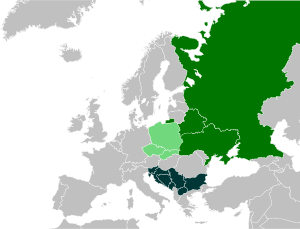
The Slavs are an Indo-European ethno-linguistic group living in Central Europe, Eastern Europe, Southeast Europe, North Asia and Central Asia, who speak the Indo-European Slavic languages, and share, to varying degrees, certain cultural traits and historical backgrounds. From the early 6th century they spread to inhabit most of Central and Eastern Europe and Southeast Europe;[33] while at the other geographic extreme, Slavic mercenaries fighting for the Byzantines and Arabs settled Asia Minor and even as far as Syria.[34] Later, East Slavs colonized Siberia[35] and Central Asia.[36] Every Slavic ethnicity has emigrated to other parts of the world. Over half of Europe's territory is inhabited by Slavic-speaking communities.[37]
Modern nations and ethnic groups called by the ethnonym Slavs are considerably diverse both genetically and culturally, and relations between them – even within the individual ethnic groups themselves – are varied, ranging from a sense of connection to mutual feelings of hostility. [38]
Present-day Slavic people are classified into West Slavic (chiefly Poles, Czechs and Slovaks), East Slavic (chiefly Russians, Belarusians, and Ukrainians), and South Slavic (chiefly Serbs, Bulgarians, Croats, Bosniaks, Macedonians, Slovenes, and Montenegrins).[39] For a more comprehensive list, see the ethnocultural subdivisions.
Ethnonym
The Slavic autonym is reconstructed in Proto-Slavic as *Slověninъ, plural *Slověně. The oldest documents written in Old Church Slavonic and dating from the 9th century attest Словѣне Slověne to describe the Slavs. Other early Slavic attestations include Old East Slavic Словѣнѣ Slověně for "an East Slavic group near Novgorod." However, the earliest written references to the Slavs under this name are in other languages. In the 6th century AD Procopius, writing in Byzantine Greek, refers to the Σκλάβοι Sklaboi, Σκλαβηνοί Sklabēnoi, Σκλαυηνοί Sklauenoi, Σθλαβηνοί Sthlauenoi, or Σκλαβῖνοι Sklabinoi,[40] while his contemporary Jordanes refers to the Sclaveni in Latin.[41]
The Slavic autonym *Slověninъ is usually considered a derivation from slovo "word", originally denoting "people who speak (the same language)," i.e. people who understand each other, in contrast to the Slavic word denoting "foreign people" – němci, meaning "mumbling, murmuring people" (from Slavic *němъ – "mumbling, mute"). The latter word may be the derivation of words to denote German/Germanic people in many later Slavic languages: e.g., Czech Němec, Slovak Nemec, Slovene Nemec, Belarusian, Russian and Bulgarian Немец, Serbian Немац, Serbian, Bosnian and Croatian Nijemac, Polish Niemiec, Ukrainian Німець, etc.,[42] but another theory states that rather these words are derived from the name of the Nemetes tribe,[43][44] which is derived from the Celtic root nemeto-.[45][46]
The English word Slav could be derived from the Middle English word sclave, which was borrowed from Medieval Latin sclavus or slavus,[47] itself a borrowing and Byzantine Greek σκλάβος sklábos "slave," which was in turn apparently derived from a misunderstanding of the Slavic autonym (denoting a speaker of their own languages). The Byzantine term Sklavinoi was loaned into Arabic as Saqaliba صقالبة (sing. Saqlabi صقلبي) by medieval Arab historiographers. However, the origin of this word is disputed.[48][49]
Alternative proposals for the etymology of *Slověninъ propounded by some scholars have much less support. Lozinski argues that the word *slava once had the meaning of worshipper, in this context meaning "practicer of a common Slavic religion," and from that evolved into an ethnonym.<ref name="lozinski"Lozinski, B. Philip (2004) [1964]. Ferguson, Alan D.; Levin, Alfred, eds. "Essays in Russian History, A collection dedicated to George Vernadsky". Hamden, Connecticut: Archon Books, Vassil Karloukovski. pp. 19–30. |chapter= ignored (help)</ref> S.B. Bernstein speculates that it derives from a reconstructed Proto-Indo-European *(s)lawos, cognate to Ancient Greek λαός laós "population, people," which itself has no commonly accepted etymology.[50] Meanwhile others have pointed out that the suffix -enin indicates a man from a certain place, which in this case should be a place called Slova or Slava, possibly a river name. The Old East Slavic Slavuta for the Dnieper River was argued by Henrich Bartek (1907–1986) to be derived from slova and also the origin of Slovene.[51]
Last scientific opinions about the earliest mentions of Slavic raids across the lower River Danube show that they may be dated to the first half of the 6th century, yet no archaeological evidence of a Slavic settlement in the Balkans could be securely dated before c. 600 AD.[52][53][54]
Early history
Discourse on the early Slavs
The meaning of the term Slav depends upon the context in which it is used. This term refers to a culture (or cultures) living north of the River Danube, east of the River Elbe, and west of the River Vistula during the 530s CE.[55] In addition, Slav is an identifier for the common ethnic group.[56] Furthermore, Slav denotes any language with linguistic ties to the modern Slavic language family (which has no connection to a common culture or shared ethnicity).[57] Despite the various notions of Slav, it is unclear whether any of these descriptions add to an accurate representation of that group's history, since historians, such as George Vernadsky, Florin Curta, and Michael Karpovich have called into question how, why, and to what degree the Slavs were cohesive as a society between the 6th and 9th centuries.[58][59] When discussing the evidence that specialists use to construct a plausible history of the Slavs, the information tends to fall into three avenues of research: the archeological, the historiographic, and the linguistic.
Archaeologically, myriad physical evidence from that time period pertains to the Slavs. This evidence ranges from hill forts, to ceramic pots and fragments, to abodes. However, there are three major problems in studying the spread of early Slavic groups by purely archaeological methods. Archaeologists face difficulties in distinguishing which finds are truly Slavic and which are not.[60] In addition, many of these findings are either inaccurately carbon-dated or so isolated that they do not reflect organized Slavic settlement.[61] The combination of these facts makes it difficult to create a reliable chronology of ceramic materials, hill forts, houses, brooches, and other small artifacts. As a result, using archaeological finds without other forms of evidence is not wholly reliable for historical debates about this group.[62] The lack of grave sites also diminishes archaeologists' abilities to assess how the Slavs changed as a people, both in terms of their social behavior and their migratory patterns. Consequently, discerning where in northern Europe Slavic groups lived during the 6th to 9th centuries represents a challenge. The cumulative effects of these difficulties prevents the construction of a thorough history of Slavic development in Northern Europe during this period through archaeological evidence alone.

Historiographically, a number of sources describe the Slavs. However there are several problems using these texts to build upon the available knowledge of the early Slavs, even when used in a multidisciplinary fashion. The useful historical information about the Slavs from these texts is either cryptic or lacks any mention of their sources.[63] Moreover, these works tend to discuss the Slavs only in terms of their effects on surrounding empires, particularly the Byzantines and the Franks. The variety of names from historiographic texts that refer to the Slavs, such as the Antes, Sclaveni and Venethi, in addition to the locales and regions which they at one point or another occupied, makes it laborious to establish a geographical boundary for major Slavic settlement. This is a troublesome task when the names of these places have not always remained the same or even survived. Most importantly, the majority of the texts utilized to describe the Slavs during this period are either second-hand accounts or describe an encounter with these groups years, decades, or centuries after it occurred. While earlier texts contextualize the Slavs' early history and later development, texts written about an event long after it had occurred make the relevant information less reliable. Unfortunately, neither earlier nor later texts directly aid understanding of the Slavs during the 6th to 9th centuries.
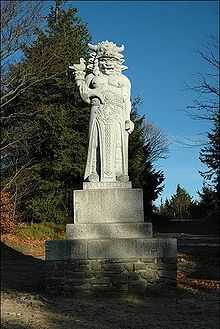
Linguistically, the pursuit of a Slavic history is also problematic. This pursuit has focused on three main areas of study: Slavic geographical names, names of flora and fauna, and "lexical and structural similarities and differences between Slavic and other languages.[64] " The use of ethnic identifiers in written texts during and after the 500s, such as the description of the Slavs as Antes, Sclaveni, and Venethi by their immediate neighbors, produces problems. Moreover, the concept of ethnicity during this period was so fluid that different ethnicities would be ascribed to the same group depending upon the situation of the encounter, such as in Michal Parczewski's map. This map, a conglomeration of different written fragments about the Slavs' homeland, selectively draws upon these fragments. In order to validate his preconceived theories about Slavic migration, Parczewski omitted information from his sources which directly contradicted his conclusions, thus making the map of Slavic settlement in relation to their neighbors during the 6th century extremely suspect.[65] Moreover, the association of particular styles of pots and burials with specific ethnonyms by archaeologists, and extremely selective use of historiographic materials, presumes a direct connection between language and ethnicity. These facts reinforce how subjective ethnic identification can be, especially in a region where many tribal groups existed and identified themselves as distinct from one another.[66][67]
The history of the early Slavs is inseparable from the political agenda behind much 19th- and 20th-century archaeological, linguistic, and historiographic research. Florin Curta, an expert on the history of the early Slavs, contends that the process of creating such a history "was a function of both ethnic formation and ethnic identification".[68] However, this process became extremely blurred by a myriad of interests. These agendas ranged from Pan-Slavic researchers in Central and Eastern Europe during the 18th and 19th centuries,[69] to post-World War Two European nations strengthening their newfound legitimacy,[70][71] to contemporary politicization of historical, archaeological, and linguistic discourse.[72]
Origins
Homeland
The location of the Slavic homeland has been the subject of significant debate. The Prague-Penkov-Kolochin complex of cultures of the 6th to 7th centuries AD are generally accepted to reflect the expansion of Slavic-speakers at that time.[73] Serious candidates for the core from which they expanded are cultures within the territories of modern Belarus, Poland, and Ukraine. The proposed frameworks are:
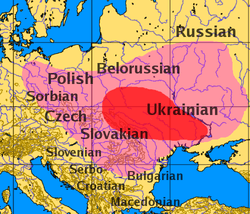
- Milograd culture hypothesis: The pre-Proto-Slavs (or Balto-Slavs) were the bearers of the Milograd culture (7th century BC to 1st century AD) of northern Ukraine and southern Belarus.
- Chernoles culture hypothesis: The pre-Proto-Slavs were the bearers of the Chernoles culture (750–200 BC) of northern Ukraine, and later the Zarubintsy culture (3rd century BC to 1st century AD).
- Lusatian culture hypothesis: The pre-Proto-Slavs were present in north-eastern Central Europe since at least the late 2nd millennium BCE, and were the bearers of the Lusatian culture (1300–500 BC), and later the Przeworsk culture (2nd century BC to 4th century AD).
- Danube basin hypothesis: postulated by Oleg Trubachyov;[74] sustained at present by Florin Curta, also supported by an early Medieval Slavic narrative source – Nestor's Chronicle
-

Areas of the Slavic "homeland", according to archaeological findings cited by Mallory.
-
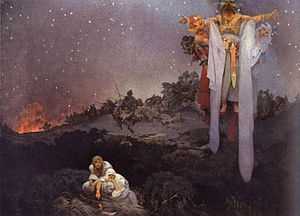
Slavs in their Original Homeland, by Alphonse Mucha
Ethnogenesis scenarios
The Globular Amphora culture stretches from the middle Dnieper to the Elbe in the late 4th and early 3rd millennia BCE. It has been suggested as the locus of a Germano-Balto-Slavic continuum (compare Germanic substrate hypothesis), but the identification of its bearers as Indo-Europeans is uncertain. The area of this culture contains numerous tumuli – typical for IE originators.
The Chernoles culture (8th to 3rd centuries BC, sometimes associated with the "Scythian farmers" of Herodotus) is "sometimes portrayed as either a state in the development of the Slavic languages or at least some form of late Indo-European ancestral to the evolution of the Slavic stock."[75] The Milograd culture (700 BCE – 100 CE), centered roughly on present-day Belarus, north of the contemporaneous Chernoles culture, has also been proposed as ancestral to either Slavs or Balts.
The ethnic composition of the bearers of the Przeworsk culture (2nd century BC to the 4th century AD, associated with the Lugii) of central and southern Poland, northern Slovakia and Ukraine, including the Zarubintsy culture (2nd century BCE to the 2nd century CE, also connected with the Bastarnae tribe) and the Oksywie culture are other candidates.
The area of southern Ukraine is known to have been inhabited by Scythian and Sarmatian tribes prior to the foundation of the Gothic kingdom. Early Slavic stone stelae found in the middle Dniester region are markedly different from the Scythian and Sarmatian stelae found in the Crimea.
The Wielbark Culture displaced the eastern Oksywie part of the Przeworsk culture from the 1st century AD. While the Chernyakhov culture; 2nd to 5th centuries CE leads to the decline of the late Sarmatian culture in the 2nd to 4th centuries, the western part of the Przeworsk culture remains intact until the 4th century, and the Kiev culture flourishes during the same time, in the 2nd to 5th centuries AD. This latter culture is recognized as the direct predecessor of the Prague-Korchak and Pen'kovo cultures (6th–7th centuries AD), the first archaeological cultures the bearers of which are indisputably identified as Slavic.
Proto-Slavic is thus likely to have reached its final stage in the Kiev area; there is, however, substantial disagreement in the scientific community over the identity of the Kiev culture's predecessors, with some scholars tracing it from the Ruthenian Milograd culture, others from the "Ukrainian" Chernoles and Zarubintsy cultures and still others from the "Polish" Przeworsk culture.
Research history
The starting point in the autochthonous/allochthonous debate was the year 1745, when Johann Christoph de Jordan published De Originibus Slavicis. The works of Slovak philologist and poet Pavel Jozef Šafárik (1795–1861) has influenced generations of scholars. The foundation of his theory was the work of Jordanes, the Getica. Jordanes had equated the Sclavenes and the Antes to the Venethi (or Venedi) also known from much earlier sources, such as Pliny the Elder, Tacitus and Ptolemy. Šafárik bequeathed to posterity not only his vision of a Slavic history, but also a powerful methodology for exploring its Dark Ages: language.[58] The Polish scholar Tadeusz Wojciechowski (1839–1919) was the first to use place names to write Slavic history. He was followed by A. L. Pogodin and the Polish botanist, J. Rostafinski.
The first to introduce archaeological data into the scholarly discourse about the early Slavs, Lubor Niederle (1865–1944), endorsed Rostafinski's theory in his multi-volume work The Antiquities of the Slavs. Vykentyi V.Khvoika (1850–1914), a Ukrainian archaeologist of Czech origin, linked the Slavs with Neolithic Cucuteni culture. A. A. Spicyn (1858–1931) assigned to the Antes the finds of silver and bronze in central and southern Ukraine. Czech archaeologist Ivan Borkovsky (1897–1976) postulated the existence of a pottery "Prague type" which was a national, exclusively Slavic, pottery. Boris Rybakov, has issued a theory that made a link between both Spicyn's "Antian antiquities" and the remains excavated by Khvoika from Chernyakhov culture and that those should be attributed to the Slavs.[58]
From the 19th century onwards, the debate became politically charged, particularly in connection with the history of the Partitions of Poland and German imperialism known as Drang nach Osten. The question whether Germanic or Slavic peoples were indigenous on the land east of the River Oder was used by factions to pursue their respective German and Polish political claims to governance of those lands.
Geneticists entered the debate in the 21st century. See the Genetics section.
Earliest accounts
The relationship between the Slavs and a tribe called the Veneti east of the River Vistula in the Roman period is uncertain. The name may refer both to Balts and Slavs.
The Slavs under name of the Antes and the Sclaveni make their first appearance in Byzantine records in the early 6th century. Byzantine historiographers under Justinian I (527–565), such as Procopius of Caesarea, Jordanes and Theophylact Simocatta describe tribes of these names emerging from the area of the Carpathian Mountains, the lower Danube and the Black Sea, invading the Danubian provinces of the Eastern Empire.
Procopius wrote in 545 that "the Sclaveni and the Antae actually had a single name in the remote past; for they were both called Spori in olden times." He describes their social structure and beliefs:
For these nations, the Sclaveni and the Antae, are not ruled by one man, but they have lived from of old under a democracy, and consequently everything which involves their welfare, whether for good or for ill, is referred to the people. It is also true that in all other matters, practically speaking, these two barbarian peoples have had from ancient times the same institutions and customs. For they believe that one god, the maker of lightning, is alone lord of all things, and they sacrifice to him cattle and all other victims.
He mentions that they were tall and hardy:
"They live in pitiful hovels which they set up far apart from one another, but, as a general thing, every man is constantly changing his place of abode. When they enter battle, the majority of them go against their enemy on foot carrying little shields and javelins in their hands, but they never wear corselets. Indeed, some of them do not wear even a shirt or a cloak, but gathering their trews up as far as to their private parts they enter into battle with their opponents. And both the two peoples have also the same language, an utterly barbarous tongue. Nay further, they do not differ at all from one another in appearance. For they are all exceptionally tall and stalwart men, while their bodies and hair are neither very fair or blond, nor indeed do they incline entirely to the dark type, but they are all slightly ruddy in color. And they live a hard life, giving no heed to bodily comforts ...".[76]
Jordanes tells us that the Sclaveni had swamps and forests for their cities.[77] Another 6th-century source refers to them living among nearly impenetrable forests, rivers, lakes, and marshes.[78]
Menander Protector mentions a Daurentius (577–579) that slew an Avar envoy of Khagan Bayan I. The Avars asked the Slavs to accept the suzerainty of the Avars, he however declined and is reported as saying: "Others do not conquer our land, we conquer theirs – so it shall always be for us".[79]
Migrations
According to eastern homeland theory, prior to becoming known to the Roman world, Slavic-speaking tribes were part of the many multi-ethnic confederacies of Eurasia – such as the Sarmatian, Hun and Gothic empires. The Slavs emerged from obscurity when the westward movement of Germans in the 5th and 6th centuries CE (thought to be in conjunction with the movement of peoples from Siberia and Eastern Europe: Huns, and later Avars and Bulgars) started the great migration of the Slavs, who settled the lands abandoned by Germanic tribes fleeing the Huns and their allies: westward into the country between the Oder and the Elbe-Saale line; southward into Bohemia, Moravia, much of present day Austria, the Pannonian plain and the Balkans; and northward along the upper Dnieper river. Perhaps some Slavs migrated with the movement of the Vandals to Iberia and north Africa.[80]
Around the 6th century, Slavs appeared on Byzantine borders in great numbers.[81] The Byzantine records note that grass would not regrow in places where the Slavs had marched through, so great were their numbers. After a military movement even the Peloponnese and Asia Minor were reported to have Slavic settlements.[82] This southern movement has traditionally been seen as an invasive expansion.[83] By the end of the 6th century, Slavs had settled the Eastern Alps regions.
Early Slavic states
When their migratory movements ended, there appeared among the Slavs the first rudiments of state organizations, each headed by a prince with a treasury and a defense force. Moreover, it was the beginnings of class differentiation, and nobles pledged allegiance either to the Frankish/ Holy Roman Emperors or the Byzantine Emperors.
In the 7th century, the Frankish merchant Samo, who supported the Slavs fighting their Avar rulers, became the ruler of the first known Slav state in Central Europe, which, however, most probably did not outlive its founder and ruler. This provided the foundation for subsequent Slavic states to arise on the former territory of this realm with Carantania being the oldest of them. Very old also are the Principality of Nitra and the Moravian principality (see under Great Moravia). In this period, there existed central Slavic groups and states such as the Balaton Principality, but the subsequent expansion of the Magyars, as well as the Germanisation of Austria, separated the northern and southern Slavs. The First Bulgarian Empire was founded in 681, the Slavic language Old Bulgarian became the main and official of the empire in 864. Bulgaria was instrumental in the spread of Slavic literacy and Christianity to the rest of the Slavic world.
-

Living of East Slavs, by Sergey Ivanov
-

Adalbert of Prague liberates Slavic slaves from the slave traders, relief of Gniezno Doors
-
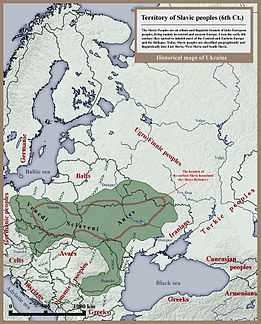
Slavic peoples in 6th century
-
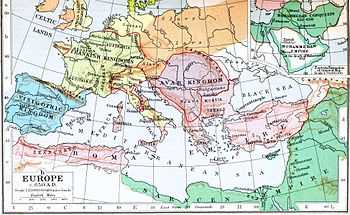
Slavs c. 650 AD
-

Slavic tribes from the 7th to 9th centuries in Europe
-

East Slavic tribes in 8th and 9th centuries
Assimilation
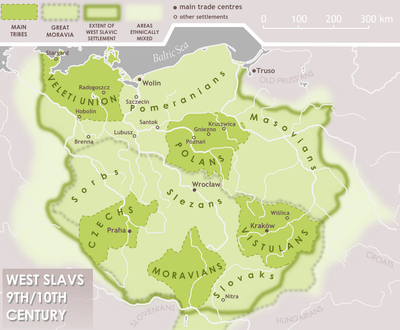

Throughout their history, Slavs came into contact with non-Slavic groups. In the postulated homeland region (present-day Ukraine), they had contacts with the Iranic Sarmatians and the Germanic Goths. After their subsequent spread, they began assimilating non-Slavic peoples. For example, in the Balkans, there were Paleo-Balkan peoples, such as Romanized and Hellenized (Jireček Line) Illyrians, Thracians and Dacians, as well as Greeks and Celtic Scordisci. Over time, due to the larger number of Slavs, most descendants of the indigenous populations of the Balkans were Slavicized. The Thracians and Illyrians vanished from the population during this period – although the modern Albanian nation claims descent from the Illyrians. Exceptions are Greece, where the lesser numbered Slavs scattered there came to be Hellenized (aided in time by more Greeks returning to Greece in the 9th century and the role of the church and administration)[84] and Romania where Slavic people settled en route for present-day Greece, Republic of Macedonia, Bulgaria and East Thrace whereby the Slavic population had come to assimilate. Bulgars were also assimilated by local Slavs but their ruling status and subsequent land cast the nominal legacy of Bulgarian country and people onto all future generations. The Romance speakers within the fortified Dalmatian cities managed to retain their culture and language for a long time,[85] as Dalmatian Romance was spoken until the high Middle Ages. However, they too were eventually assimilated into the body of Slavs.
In the Western Balkans, South Slavs and Germanic Gepids intermarried with Avar invaders, eventually producing a Slavicized population. In Central Europe, the Slavs intermixed with Germanic and Celtic, while the eastern Slavs encountered Uralic and Scandinavian peoples. Scandinavians (Varangians) and Finnic peoples were involved in the early formation of the Rus state but were completely Slavicized after a century. Some Finno-Ugric tribes in the north were also absorbed into the expanding Rus population.[86] At the time of the Magyar migration, the present-day Hungary was inhabited by Slavs, numbering about 200,000,[87] and by Romano-Dacians who were either assimilated or enslaved by the Magyars.[87] In the 11th and 12th centuries, constant incursions by nomadic Turkic tribes, such as the Kipchaks and the Pechenegs, caused a massive migration of East Slavic populations to the safer, heavily forested regions of the north.[88] In the Middle Ages, groups of Saxon ore miners settled in medieval Bosnia, Serbia and Bulgaria where they were Slavicized.

Polabian Slavs (Wends) settled in parts of England (Danelaw), apparently as Danish allies.[89] Polabian-Pomeranian Slavs are also known to have even settled on Norse age Iceland. Saqaliba refers to the Slavic mercenaries and slaves in the medieval Arab world in North Africa, Sicily and Al-Andalus. Saqaliba served as caliph's guards.[90][91] In the 12th century, there was intensification of Slavic piracy in the Baltics. The Wendish Crusade was started against the Polabian Slavs in 1147, as a part of the Northern Crusades. Niklot, pagan chief of the Slavic Obodrites, began his open resistance when Lothar III, Holy Roman Emperor, invaded Slavic lands. In August 1160 Niklot was killed and German colonization (Ostsiedlung) of the Elbe-Oder region began. In Hanoverian Wendland, Mecklenburg-Vorpommern and Lusatia invaders started germanization. Early forms of germanization were described by German monks: Helmold in the manuscript Chronicon Slavorum and Adam of Bremen in Gesta Hammaburgensis ecclesiae pontificum.[92] The Polabian language survived until the beginning of the 19th century in what is now the German state of Lower Saxony.[93]
Cossacks, although Slavic-speaking and Orthodox Christians, came from a mix of ethnic backgrounds, including Tatars and other Turks. Many early members of the Terek Cossacks were Ossetians.
The Gorals of southern Poland and northern Slovakia are partially descended from Romance-speaking Vlachs who migrated into the region from the 14th to 17th centuries and were absorbed into the local population. The population of Moravian Wallachia also descend of this population.
Conversely, some Slavs were assimilated into other populations. Although the majority continued south, attracted by the riches of the territory which would become Bulgaria, a few remained in the Carpathian basin and were ultimately assimilated into the Magyar or Romanian population. There is a large number of river names and other placenames of Slavic origin in Romania.[94] Similarly, the populations of the respective southern and eastern parts of Austria and eastern parts of Germany are to some degree made up of people with Slavic ancestry.
Modern history

.jpg)
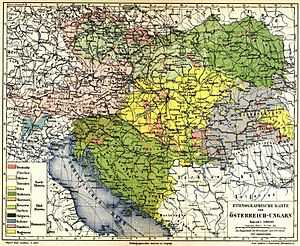
As of 1878, there were only three free Slavic states in the world: the Russian Empire, Serbia and Montenegro. Bulgaria was also free but was de jure vassal to the Ottoman Empire until official independence was declared in 1908. In the entire Austro-Hungarian Empire of approximately 50 million people, about 23 million were Slavs. The Slavic peoples who were, for the most part, denied a voice in the affairs of the Austro-Hungarian Empire, were calling for national self-determination. During World War I, representatives of the Czechs, Slovaks, Poles, Serbs, Croats, and Slovenes set up organizations in the Allied countries to gain sympathy and recognition.[95] In 1918, after World War I ended, the Slavs established such independent states as Czechoslovakia, the Second Polish Republic, and the State of Slovenes, Croats and Serbs.
During World War II, Hitler's Generalplan Ost (general plan for the East) entailed killing, deporting, or enslaving the Slavic and Jewish population of occupied Eastern Europe to create Lebensraum (living space) for German settlers.[96] The Nazi Hunger Plan and Generalplan Ost would have led to the starvation of 80 million people in the Soviet Union.[97] These partially fulfilled plans resulted in the deaths of an estimated 19.3 million civilians and prisoners of war.[98]
The first half of the 20th century in Russia and the Soviet Union was marked by a succession of wars, famines and other disasters, each accompanied by large-scale population losses.[99] Stephen J. Lee estimates that, by the end of World War II in 1945, the Russian population was about 90 million fewer than it could have been otherwise.[100]
Because of the vastness and diversity of the territory occupied by Slavic people, there were several centers of Slavic consolidation. In the 19th century, Pan-Slavism developed as a movement among intellectuals, scholars, and poets, but it rarely influenced practical politics and did not find support in some nations that had Slavic origins. Pan-Slavism became compromised when the Russian Empire started to use it as an ideology justifying its territorial conquests in Central Europe as well as subjugation of other ethnic groups of Slavic origins such as Poles and Ukrainians, and the ideology became associated with Russian imperialism. The common Slavic experience of communism combined with the repeated usage of the ideology by Soviet propaganda after World War II within the Eastern bloc (Warsaw Pact) was a forced high-level political and economic hegemony of the USSR dominated by Russians. A notable political union of the 20th century that covered most South Slavs was Yugoslavia, but it ultimately broke apart in the 1990s along with the Soviet Union.
The word "Slavs" was used in the national anthem of the Slovak Republic (1939–1945), Yugoslavia (1943–1992) and the Federal Republic of Yugoslavia (1992–2003), later Serbia and Montenegro (2003–2006).
Former Soviet states such as Kazakhstan, have very large minority Slavic populations with most being Russians. Also former satellite states and Warsaw Pact territories also have large minority Slavic populations also being Russian or Ukrainian and those from the three Slavic states in the Soviet Union. As of now, Kazakhstan have the largest Slavic minority population, with most being Russians.
Pan-Slavism
Pan-Slavism, a movement which came into prominence in the mid-19th century, emphasized the common heritage and unity of all the Slavic peoples. The main focus was in the Balkans where the South Slavs had been ruled for centuries by other empires: the Byzantine Empire, Austria-Hungary, the Ottoman Empire, and Venice. The Russian Empire used Pan-Slavism as a political tool; as did the Soviet Union, which gained political-military influence and control over most Slavic-majority nations between 1945 and 1948 and retained a hegemonic role until the period 1989–1991.
Culture

Language
Slavic studies began as an almost exclusively linguistic and philological enterprise. As early as 1833, Slavic languages were recognized as Indo-European.[58]
Slavic standard languages which are official in at least one country: Belarusian, Bosnian, Bulgarian, Croatian, Czech, Macedonian, Montenegrin, Polish, Russian, Serbian, Slovak, Slovene, and Ukrainian.
Proto-Slavic language

Proto-Slavic, the supposed ancestor language of all Slavic languages, is a descendant of common Proto-Indo-European, via a Balto-Slavic stage in which it developed numerous lexical and morphophonological isoglosses with the Baltic languages. In the framework of the Kurgan hypothesis, "the Indo-Europeans who remained after the migrations [from the steppe] became speakers of Balto-Slavic".[101]
Proto-Slavic, sometimes referred to as Common Slavic or Late Proto-Slavic, is defined as the last stage of the language preceding the geographical split of the historical Slavic languages. That language was uniform, and on the basis of borrowings from foreign languages and Slavic borrowings into other languages, cannot be said to have any recognizable dialects, suggesting a comparatively compact homeland.[102] Slavic linguistic unity was to some extent visible as late as Old Church Slavonic manuscripts which, though based on local Slavic speech of Thessaloniki, could still serve the purpose of the first common Slavic literary language.[103]
Alphabet

The alphabet depends on what religion is usual for the respective Slavic ethnic groups. The Orthodox use the Cyrillic alphabet and the Roman Catholics use Latin alphabet, the Bosniaks who are Muslims also use the Latin. Few Greek Roman and Roman Catholics use the Cyrillic alphabet however. The Serbian language and Montenegrin language uses both Cyrillic and Latin alphabets. There is also a Latin script to write in Belarusian, called the Lacinka alphabet.
Religion
Most Slavic populations gradually adopted Christianity (Orthodox Christianity for the East Slavs and Roman Catholicism for the West Slavs, with South Slavs split by the two churches) between the 6th and 10th centuries, and consequently their old pagan beliefs declined. See also Slavic Neopaganism.
The majority of contemporary Slavs who profess a religion are Orthodox, followed by Roman Catholic. A very small minority are Protestant. Bosniaks, Gorani, Torbeshi and Pomaks are Muslims, and many other Slavic ethnic groups have lived in close contact with the Muslim world for centuries. Religious delineations by nationality can be very sharp; usually in the Slavic ethnic groups the vast majority of religious people share the same religion. Some Slavs are atheist or agnostic: only 19% of Czechs professed belief in god/s in the 2005 Eurobarometer survey.
The main Slavic ethnic groups by religion:
Mainly Eastern Orthodoxy:
|
Ethnocultural subdivisions

Slavs are customarily divided along geographical lines into three major subgroups: East Slavs, West Slavs, and South Slavs, each with a different and a diverse background based on unique history, religion and culture of particular Slavic group within them. Apart from prehistorical archaeological cultures, the subgroups have had notable cultural contact with non-Slavic Bronze- and Iron Age civilisations.
- The West Slavs have origins in early Slavic tribes that settled in Central Europe after the Germanic tribes had left this area during the migration period.[104] The West Slavs were influenced by the Western Roman Empire (Latin) and the Roman Catholic Church.
- The East Slavs have origins in early Slavic tribes who mixed with the local Sarmatian tribes (Alans) and Scythians, Hellenic colonies, as well as Uralic peoples. The East Slavs trace their nation-building to the tribal unions of Kievan Rus', beginning in the 10th century. The East Slavs were particularly influenced by the Eastern Roman Empire (Byzantine Empire) and the Eastern Orthodox Church, while Eastern Catholic Churches were established in the 16th century in areas such of Ukraine.
- The South Slavs except Slovenes and Croats have origins in early Slavic tribes who mixed with the local Proto-Balkanic tribes (Illyrian, Dacian, Thracian, Pannonian, Paeonian and Hellenic tribes), Celtic tribes (most notably the Scordisci), as well as Romans (and the Romanized remnants of the former groups), and also remnants of temporarily settled invading East Germanic, Asiatic or Caucasian tribes such as Gepids, Huns, Avars and Bulgars. The Slovenes and the Croats have origins in early Slavic tribes who mixed with Romans and romanized Celtic and Illyrian people as well as with Avars and Germanic peoples of Lombards and East Goths. The South Slavs except Slovenes and Croats were particularly influenced by the Eastern Roman Empire (Byzantine Empire), Ottoman Empire and thus with the Eastern Orthodox Church and Islam, while the Slovenes and the Croats were influenced by Western Roman Empire (Latin), Holy Roman Empire and thus with the Roman Catholic Church and Lutheran Protestant Reformation.
West Slavs
Czech-Slovak group
Lechitic group
East Slavs
South Slavs
Eastern group
|
|
Western group
- Notes
^e Extinct
^1 Also considered part of Rusyns
^2 Considered transitional between Ukrainians and Belarusians
^3 The ethnic affiliation of the Lemkos has become an ideological conflict. It has been alleged that among the Lemkos the idea of "Carpatho-Ruthenian" nation is supported only by Lemkos residing in Transcarpathia and abroad[105]
^4 Most inhabitants of historic Moravia considered themselves as Czechs but significant amount declared their Moravian nationality, different from that Czech (although people from Bohemia and Moravia use the same official language).
^5 Also considered Poles.
^6 There are sources that show Silesians as part of the Poles.[106] Parts of the southmost population of Upper Silesia is sometimes considered Czech (controversial).
^7 A census category recognized as an ethnic group. Most Slavic Muslims (especially in Bosnia, Croatia, Montenegro and Serbia) now opt for Bosniak ethnicity, but some still use the "Muslim" designation. Bosniak and Muslim are considered two ethnonyms for a single ethnicity and the terms may even be used interchangeably. However, a small number of people within Bosnia and Herzegovina declare Bosniak but are not necessarily Muslim by faith.
^8 This identity continues to be used by a minority throughout the former Yugoslav republics. The nationality is also declared by diasporans living in the USA and Canada. There are a multitude of reasons as to why people prefer this affiliation, some published on the article.
^9 Sub-groups of Croats include Bunjevci (in Bačka), Šokci (in Slavonia and Vojvodina), Janjevci (in Kosovo), Burgenland Croats (in Austria), Bosniaks (in Hungary), Molise Croats (in Italy), Krashovans (in Romania), Moravian Croats (in the Czech Republic)
^10 Sub-groups of Slovenes include Prekmurians, Hungarian Slovenes, Carinthian Slovenes, Venetian Slovenes, Resians, and the extinct Carantanians and Somogy Slovenes.
Note: Besides ethnic groups, Slavs often identify themselves with the local geographical region in which they live. Some of the major regional South Slavic groups include: Zagorci in northern Croatia, Istrijani in westernmost Croatia, Dalmatinci in southern Croatia, Boduli in Adriatic islands, Vlaji in hinterland of Dalmatia, Slavonci in eastern Croatia, Bosanci in Bosnia, Hercegovci in Herzegovina, Krajišnici in western Bosnia, Semberci in northeast Bosnia, Srbijanci in Serbia proper, Šumadinci in central Serbia, Vojvođani in northern Serbia, Sremci in Syrmia, Bačvani in northwest Vojvodina, Banaćani in Banat, Sandžaklije (Muslims in Serbia/Montenegro border), Kosovci in Kosovo, Bokelji in southwest Montenegro, Trakiytsi in Upper Thracian Lowlands, Dobrudzhantsi in north-east Bulgarian region, Balkandzhii in Central Balkan Mountains, Miziytsi in north Bulgarian region, Warmiaks and Masurians in north-east Polish regions Warmia and Mazuria, Pirintsi in Blagoevgrad Province, Ruptsi in the Rhodopes etc.
Another interesting note is that the very term Slavic itself was registered in the US census of 2000 by more than 127,000 residents.
Genetics

The modern Slavic peoples carry a variety of Mitochondrial DNA haplogroups and Y-chromosome DNA haplogroups. Yet two paternal haplogroups predominate: R1a1a [M17] and I2a2a [L69.2=T/S163.2]. The frequency of Haplogroup R1a ranges from 63.39% in the Sorbs, through 56.4% in Poland, 54% in Ukraine, 52% in Russia, Belarus, to 15.2% in Republic of Macedonia, 14.7% in Bulgaria and 12.1% in Herzegovina.[107] The correlation between R1a1a [M17] and the speakers of Indo-European languages, particularly those of Eastern Europe (Russian) and Central and Southern Asia, was noticed in the late 1990s. From this Spencer Wells and colleagues, following the Kurgan hypothesis, deduced that R1a1a arose on the Pontic-Caspian steppe.[108]
Specific studies of Slavic genetics followed. In 2007 Rębała and colleagues studied several Slavic populations with the aim of localizing the Proto-Slavic homeland.[109] The significant findings of this study are that:
- Two genetically distant groups of Slavic populations were revealed: One encompassing all Western-Slavic, Eastern-Slavic, and few Southern-Slavic populations (north-western Croats and Slovenes), and one encompassing all remaining Southern Slavs. According to the authors most Slavic populations have similar Y chromosome pools — R1a. They speculate that this similarity can be traced to an origin in the middle Dnieper basin of Ukraine during the Late Glacial Maximum 15 kya.[110]
- However, Southern-Slavic populations including the Bosnians, Croats (excluding north-western Croatia), Serbs, Bulgarians and Macedonians are clearly separated from the tight DNA cluster of the rest of the Slavic populations. According to the authors this phenomenon is explained by "... contribution to the Y chromosomes of peoples who settled in the Balkan region before the Slavic expansion to the genetic heritage of Southern Slavs ..."[110]
Marcin Woźniak and colleagues (2010) searched for specifically Slavic sub-group of R1a1a [M17]. Working with haplotypes, they found a pattern among Western Slavs which turned out to correspond to a newly discovered marker, M458, which defines subclade R1a1a7. This marker correlates remarkably well with the distribution of Slavic-speakers today. The team led by Peter Underhill, which discovered M458, did not consider the possibility that this was a Slavic marker, since they used the "evolutionary effective" mutation rate, which gave a date far too old to be Slavic. Woźniak and colleagues pointed out that the pedigree mutation rate, giving a later date, is more consistent with the archaeological record.[111]
Pomors are distinguished by the presence of Y Haplogroup N among them. Postulated to originate from southeast Asia, it is found at high rates in Uralic peoples. Its presence in Pomors (called "Northern Russians" in the report) attests to the non-Slavic tribes (mixing with Finnic tribes of northern Eurasia).[86] Autosomally, Russians are generally similar to populations in central-eastern Europe but some northern Russians are intermediate to Finno-Ugric groups.[112]
On the other hand I2a1b1 (P41.2) is typical of the South Slavic populations, being highest in Bosnia-Herzegovina (>50%).[107] Haplogroup I2a2 is also commonly found in north-eastern Italians.[113] There is also a high concentration of I2a2a in the Moldavian region of Romania, Moldova and western Ukraine. According to original studies, Hg I2a2 was believed to have arisen in the west Balkans sometime after the LGM, subsequently spreading from the Balkans through Central Russian Plain. Recently, Ken Nordtvedt has split I2a2 into two clades – N (northern) and S (southern), in relation where they arose compared to Danube river.[114] He proposes that N is slightly older than S. He recalculated the age of I2a2 to be ~ 2550 years and proposed that the current distribution is explained by a Slavic expansion from the area north-east of the Carpathians.
In 2008, biochemist Boris Abramovich Malyarchuk (Russian: Борис Абрамович Малярчук) et al. of the Institute of Biological Problems of the North, Russian Academy of Sciences, Magadan, Russia, used a sample (n=279) of Czech individuals to determine the frequency of "Mongoloid" "mtDNA lineages".[115] Malyarchuk found Czech mtDNA lineages were typical of "Slavic populations" with "1.8%" Mongoloid mtDNA lineage.[115] Malyarchuk added that "Slavic populations" "almost always" contain Mongoloid mtDNA lineage.[115] Malyarchuk said the Mongoloid component of Slavic people was partially added before the split of "Balto-Slavics" in 2,000–3,000 BC with additional Mongoloid mixture occurring among Slavics in the last 4,000 years.[115] Malyarchuk said the "Russian population" was developed by the "assimilation of the indigenous pre-Slavic population of Eastern Europe by true Slavs" with additional "assimilation of Finno-Ugric populations" and "long-lasting" interactions with the populations of "Siberia" and "Central Asia".[115] Malyarchuk said that other Slavs "Mongoloid component" was increased during the waves of migration from "steppe populations (Huns, Avars, Bulgars and Mongols)", especially the decay of the "Avar Khaganate".[115]
DNA samples from 1228 Russians show that the Y chromosomes analyzed, all except 20 (1.6%) fall into seven major haplogroups all characteristic to West Eurasian populations. Taken together, they account for 95% of the total Russian Y chromosomal pool. Only (0.7%) fell into haplogroups that are specific to East and South Asian populations.[116] Mitochondrial DNA (mtDNA) examined in Poles and Russians revealed the presence of all major European haplogroups, which were characterized by similar patterns of distribution in Poles and Russians. An analysis of the DNA did not reveal any specific combinations of unique mtDNA haplotypes and their subclusters. The DNA clearly shows that both Poles and Russians are not different from the neighbouring European populations.[117]
See also
| Part of a series on |
| Indo-European topics |
|---|
|
|
Philology
|
|
Origins
|
|
Archaeology |
|
Peoples and societies
|
|
Religion and mythology |
- Ethnic groups in Europe
- Gord (archaeology)
- Lech, Čech, and Rus
- List of modern ethnic groups
- Panethnicity
- List of Slavic tribes
- Pan-Slavic colors
- Slavic names
References
- ↑ The total number of Slavs is the sum of the numbers from each region below
- ↑ "Нас 150 миллионов -Русское зарубежье, российские соотечественники, русские за границей, русские за рубежом, соотечественники, русскоязычное население, русские общины, диаспора, эмиграция". Russkie.org. 2012-02-20. Retrieved 2013-04-29.
- ↑
- ↑ "Русские". rcultura. Retrieved 2013-04-29.
- ↑ "Соотечественники". Russedina.ru. Retrieved 2013-04-29.
- ↑ including 36,522,000 single ethnic identity, 871,000 multiple ethnic identity (especially 431,000 Polish and Silesian, 216,000 Polish and Kashubian and 224,000 Polish and another identity) in Poland (according to the census 2011) and estimated 20,000,000 out of Poland Świat Polonii, witryna Stowarzyszenia Wspólnota Polska: "Polacy za granicą" (Polish people abroad as per summary by Świat Polonii, internet portal of the Polish Association Wspólnota Polska)
- ↑ The Ukrainian World Congress states that the Ukrainian diaspora makes 20 million: 20mln Ukrainians living abroad
- ↑ "UWC continually and diligently defends the interests of over 20 million Ukrainians". Ucc.ca. 2010-05-25. Retrieved 2014-04-04.
- ↑ The Serbian Diaspora and Youth: Cross-Border Ties and Opportunities for Development, Theodore E. Baird, Roskilde University and Amanda Klekowski von Koppenfels, University of Kent at Brussels p. 5.
- ↑ Ethnic Groups of Europe: An Encyclopedia, Ethnic Groups of the World, Jeffrey E. Cole, ABC-CLIO, 2011, ISBN 1598843036, pp. 333–334.
- ↑ Obyvatelstvo podle národnosti podle krajů
- ↑ Kolev, Yordan, Българите извън България 1878 – 1945, 2005, р. 18 Quote:"В началото на ХХI в. общият брой на етническите българи в България и зад граница се изчислява на около 10 милиона души/In 2005 the number of Bulgarians is 10 milion people
- ↑ The Report: Bulgaria 2008, Oxford Business Group, 2008, p.8
- ↑ Daphne Winland (2004), "Croatian Diaspora", in Melvin Ember, Carol R. Ember, Ian Skoggard, Encyclopedia of Diasporas: Immigrant and Refugee Cultures Around the World. Volume I: Overviews and Topics; Volume II: Diaspora Communities 2 (illustrated ed.), Springer Science+Business, p. 76, ISBN 978-0-306-48321-9,
It is estimated that 4.5 million Croatians live outside Croatia ...
- ↑ Hrvatski Svjetski Kongres at the Wayback Machine (archived October 15, 2007), Croatian World Congress, "4.5 million Croats and people of Croatian heritage live outside of the Republic of Croatia and Bosnia and Herzegovina", also quoted here
- ↑ National Minorities in Inter-State Relations – Google Knjige. Books.google.hr. 2011-02-14. Retrieved 2013-04-29.
- ↑ including 4,353,000 in Slovakia (according to the census 2011), 147,000 single ethnic identity, 19,000 multiple ethnic identity (especially 18,000 Czech and Slovak and 1,000 Slovak and another identity) in Czech Republic (according to the census 2011), 53,000 in Serbia (according to the census 2011), 762,000 in the USA (according to the census 2010), 2,000 single ethnic identity and 1,000 multiple ethnic identity Slovak and Polish in Poland (according to the census 2011), 21,000 single ethnic identity, 43,000 multiple ethnic identity in Canada (according to the census 2006)
- ↑ Zupančič, Jernej (August 2004). "Ethnic Structure of Slovenia and Slovenes in Neighbouring Countries" (PDF). Slovenia: a geographical overview. Association of the Geographic Societies of Slovenia. Retrieved 10 April 2008.
- ↑ Nasevski, Boško; Angelova, Dora. Gerovska, Dragica (1995). Македонски Иселенички Алманах '95. Skopje: Матица на Иселениците на Македонија. pp. 52 & 53.
- ↑ Magocsi, Paul Robert (1995). "The Rusyn Question". Political Thought (http://www.litopys.org.ua/rizne/magocie.htm) 2–3 (6): 221–231.
- ↑ including 521,800 single ethnic identity, 99,000 multiple ethnic identity Czech and Moravian, 4,600 multiple ethnic identity Moravian and Silesian, 1,700 multiple ethnic identity Moravian and Slovak in the Czech Republic (according to the census 2011) and 3,300 in Slovakia (according to the census 2011)
- ↑ including 16,000 single ethnic identity, 216,000 multiple ethnic identity Polish and Kashubian, 1,000 multiple ethnic identity Kashubian and another in Poland (according to the census 2011).
- ↑ "Germany's Sorb Minority Fights to Save Villages From Vattenfall". Bloomberg. 18 December 2007.
- ↑ "Sorbs of East Germany – World Directory of Minorities". Faqs.org. Retrieved 2013-04-29.
- ↑ "Progam političke stranke GIG".
Do Nato intervencije na Srbiju, 24.03.1999.godine, u Gori je živelo oko 18.000 Goranaca. U Srbiji i bivšim jugoslovenskim republikama nalazi se oko 40.000 Goranaca, a značajan broj Goranaca živi i radi u zemljama Evropske unije i u drugim zemljama. Po našim procenama ukupan broj Goranaca, u Gori u Srbiji i u rasejanju iznosi oko 60.000.
- ↑ including 6,000 single ethnic identity, 4,000 multiple ethnic identity Lemko-Polish, 1,000 multiple ethnic identity Lemko and another in Poland (according to the census 2011).
- ↑ 23,000 in Serbia (according to the census 2011), 327,000 in the USA (according to the census 2010), 21,000 single ethnic identity and 44,000 multiple ethnic identity in Canada (according to the census 2006)
- ↑ 304,000 in the USA (according to the census 2010), 6,000 single ethnic identity and 31,000 multiple ethnic identity in Canada (according to the census 2006)
- ↑ 137,000 in the USA (according to the census 2010), in Canada (according to the census 2006) and 2,000 single ethnic identity and 4,000 multiple ethnic identity in Canada (according to the census 2006)
- ↑ 3,000 multiple ethnic identity Polish and Kociewiacy in Poland (according to the census 2011).
- ↑ 3,000 multiple ethnic identity Polish and Goral in Poland (according to the census 2011).
- ↑ 2,000 multiple ethnic identity (especially 1,000 Polish and Greaterpolish) in Poland (according to the census 2011).
- ↑ Geography and ethnic geography of the Balkans to 1500
- ↑ Curta 2001, p. 111.
- ↑ Dvornik 1962, pp. 281–282.
- ↑ Robert Greenall, Russians left behind in Central Asia, BBC News, 23 November 2005
- ↑ Barford 2001, p. 1.
- ↑ Robert Bideleux; Ian Jeffries (January 1998). A History of Eastern Europe: Crisis and Change. Psychology Press. ISBN 978-0-415-16112-1.
- ↑ Encyclopædia Britannica (2006-09-18). "Slav (people) – Britannica Online Encyclopedia". Britannica.com. Retrieved 2010-08-18.
- ↑ Procopius, History of the Wars,\, VII. 14. 22–30, VIII.40.5
- ↑ Jordanes, The Origin and Deeds of the Goths, V.33.
- ↑ Stephen Barbour and Cathie Carmichael (eds.), Language and Nationalism in Europe (2000), p. 193.
- ↑ The Journal of Indo-European studies 1974, v.2
- ↑ Etymology of the Polish-language word for Germany (Polish)
- ↑ Xavier Delamarre (2003). Dictionnaire de la langue gauloise. Éditions Errance, p. 233.
- ↑ John T. Koch (2006). Celtic Culture: A Historical Encyclopedia. ABC-CLIO, p. 1351.
- ↑ Slav, on Oxford Dictionaries
- ↑ F. Kluge, Etymologisches Wörterbuch der deutschen Sprache. 2002, siehe «Sklave»
- ↑ Ф. М. Достоевский. Полное собрание сочинений: в 30-ти т. Т. 23. М., 1990, с. 63, 382.
- ↑ Bernstein 1961
- ↑ Etudes slaves et est-européennes: Slavic and East-European studies, Volume 3 (1958), p.107.
- ↑ Florin Curta, Archeologické rozhledy LXI, 2009
- ↑ Koleva, R. 1993: Slavic settlement on the territory of Bulgaria. In: J. Pavúk ed., Actes du XII-e Congre's international des sciences préhistoriques et protohistoriques. Bratislava, 1–7 septembre 1991 IV, Bratislava,17–19.
- ↑ Angelova, S. – Koleva, R. 2007: Archäologische Zeugnisse frühslawischer Besiedlung in Bulgarien. In: J. Henning ed., Post-Roman Towns, Trade, and Settlement in Europe and Byzantium, Berlin – New York, 481–508.
- ↑ Curta 2001, pp. 335–337.
- ↑ Curta 2001, pp. 6–35.
- ↑ Paul M. Barford, 2004. Identity And Material Culture Did The Early Slavs Follow The Rules Or Did They Make Up Their Own? East Central Europe 31, no. 1:102–103
- ↑ 58.0 58.1 58.2 58.3 Curta 2001.
- ↑ Pots, Slavs and 'Imagined Communities': Slavic Archaeologies And The History of The Early Slavs. European Journal of Archaeology 4, no. 3:367–384; George Verdansky and Michael Karpovich, Ancient Russia, vol. 1 of History of Russia (New Haven: Yale University Press, 1943)
- ↑ Sebastian Brather. 2004. "The Archaeology of the Northwestern Slavs (Seventh To Ninth Centuries)". East Central Europe 31, no. 1:78–81.
- ↑ Brather, The Archaeology of the Northwestern Slavs, 79
- ↑ Barford, Identity And Material Culture, 106
- ↑ Curta 2001, pp. 36–38.
- ↑ Barford, Identity And Material Culture, 103
- ↑ Barford, Identity And Material Culture, 104-5
- ↑ Barford, Identity And Material Culture, 105-6
- ↑ Curta 2001, pp. 84–87.
- ↑ Curta 2001, p. 335.
- ↑ Barford, Identity And Material Culture, 99
- ↑ Curta 2001, pp. 358–375.
- ↑ Barford, Identity And Material Culture, 99–101, Pots, Slavs and 'Imagined Communities': Slavic Archaeologies And The History of The Early Slavs. European Journal of Archaeology 4, no. 3:370, Pavel M. Dolukhanov, The Early Slavs (New York: Addison Wesley Longman, 1996), 7
- ↑ Barford, Identity And Material Culture, 100, 102
- ↑ Peter Heather (17 December 2010). Empires and Barbarians: Migration, Development and the Birth of Europe. Pan Macmillan. pp. 389–396. ISBN 978-0-330-54021-6.
- ↑ Trubačev, O. N. 1985. Linguistics and Ethnogenesis of the Slavs: The Ancient Slavs as Evidenced by Etymology and Onomastics. Journal of Indo-European Studies (JIES), 13: 203–256.
- ↑ Douglas Q. Adams (January 1997). Encyclopedia of Indo-European Culture. Taylor & Francis. pp. 104–. ISBN 978-1-884964-98-5.
- ↑ "Procopius, History of the Wars, VII. 14. 22–30". Clas.ufl.edu. Retrieved 2014-04-04.
- ↑ Jordanes, The Origin and Deeds of the Goths, V. 35.
- ↑ Maurice's Strategikon: handbook of Byzantine military strategy, trans. G.T. Dennis (1984), p. 120.
- ↑ Curta 2001, pp. 91–92, 315.
- ↑ Mallory & Adams "Encyclopedia of Indo-European Culture
- ↑ Cyril A. Mango (1980). Byzantium, the empire of New Rome. Scribner. ISBN 978-0-684-16768-8.
- ↑ Tachiaos, Anthony-Emil N. 2001. Cyril and Methodius of Thessalonica: The Acculturation of the Slavs. Crestwood, NY: St. Vladimir's Seminary Press.
- ↑ Nystazopoulou-Pelekidou 1992: Middle Ages
- ↑ Fine 1991, p. 41
- ↑ Fine 1991, p. 35
- ↑ 86.0 86.1 Balanovsky, O; Rootsi, S; Pshenichnov, A; Kivisild, T; Churnosov, M; Evseeva, I; Pocheshkhova, E; Boldyreva, M et al. (2008). "Two Sources of the Russian Patrilineal Heritage in Their Eurasian Context". AJHG 82 (1): 236–250. doi:10.1016/j.ajhg.2007.09.019. PMC 2253976. PMID 18179905.
- ↑ 87.0 87.1 A Country Study: Hungary. Federal Research Division, Library of Congress. Retrieved 2009-03-06.
- ↑ Klyuchevsky, Vasily (1987). The course of the Russian history. v.1: "Myslʹ. ISBN 5-244-00072-1. Retrieved 2009-10-09.
- ↑ Shore, Thomas William (2008). Origin of the Anglo-Saxon Race – A Study of the Settlement of England and the Tribal Origin of the Old English People. READ BOOKS. pp. 84–102. ISBN 1-4086-3769-3.
- ↑ Lewis 1994: ch. 1
- ↑ Eigeland, Tor. 1976. The golden caliphate. Saudi Aramco World, September/October 1976, pp. 12–16.
- ↑ "Wend – Britannica Online Encyclopedia". Britannica.com. 2013-09-13. Retrieved 2014-04-04.
- ↑ "Polabian language". Britannica.com. Retrieved 2014-04-04.
- ↑ Alexandru Xenopol, Istoria românilor din Dacia Traiană, 1888, vol. I, p. 540
- ↑ Austria-Hungary
- ↑ Snyder, Timothy (2010). Bloodlands: Europe between Hitler and Stalin. New York: Basic Books. p. 416. ISBN 978-0-465-00239-9.
- ↑ Dorland, Michael (2009). Cadaverland: Inventing a Pathology of Catastrophe for Holocaust Survival: The Limits of Medical Knowledge and Memory in France. Tauber Institute for the Study of European Jewry series. Waltham, Mass: University Press of New England. p. 6. ISBN 1-58465-784-7.
- ↑ Rummel, Rudolph (1994). Death by Government. New Brunswick, NJ: Transaction. p. 112]. ISBN 978-1-56000-145-4.
- ↑ Mark Harrison (2002). "Accounting for War: Soviet Production, Employment, and the Defence Burden, 1940–1945". Cambridge University Press. p.167. ISBN 0-521-89424-7
- ↑ Stephen J. Lee (2000). "European dictatorships, 1918–1945". Routledge. p.86. ISBN 0-415-23046-2.
- ↑ F. Kortlandt, The spread of the Indo-Europeans, Journal of Indo-European Studies, vol. 18 (1990), pp. 131–140. Online version, p.4.
- ↑ F. Kortlandt, The spread of the Indo-Europeans, Journal of Indo-European Studies, vol. 18 (1990), pp. 131–140. Online version, p.3.
- ↑ J.P. Mallory and D.Q. Adams, The Oxford Introduction to Proto-Indo-European and the Proto-Indo-European World (2006), pp. 25–26.
- ↑ Zbigniew Kobyliński, The Slavs 'in:' Paul Fouracre (red.) The New Cambridge Medieval History, pp. 530–537
- ↑ Who are we, lemko.org
- ↑ Regina E. Holloman, Serghei A. Arutiunov, Perspectives on Ethnicity, Walter de Gruyter 1978, p. 391, ISBN 3-11-080770-X, 9783110807707 Google Books; P. Eberhardt, Ethnic Groups and Population Changes in Twentieth-century Central-Eastern Europe: History, Data, and Analysis, M.E. Sharpe, 2003, p. 166, ISBN 0-7656-1833-8, 9780765618337 Google books; Jeffrey E. Cole, Ethnic Groups of Europe: An Encyclopedia, ABC-CLIO, 2011, p. 340, ISBN 1-59884-303-6, 9781598843033 Google books
- ↑ 107.0 107.1 Peričić, Marijana, et al.. 2005. High-Resolution Phylogenetic Analysis of Southeastern Europe Traces Major Episodes of Paternal Gene Flow Among Slavic Populations. Molecular Biology and Evolution, 2005 22(10): 1964–1975; doi:10.1093/molbev/msi185.
- ↑ Wells et al., The Eurasian Heartland: A continental perspective on Y-chromosome diversity," Proceedings of the National Academy of Sciences of the United States of America, vol. 98, no. 18 (2001), pp. 10244–10249; the connection between Y-DNA R-M17 and the spread of Indo-European languages was first proposed by T. Zerjal et al., "The use of Y-chromosomal DNA variation to investigate population history: recent male spread in Asia and Europe," in S.S. Papiha, R. Deka and R. Chakraborty (eds.), Genomic Diversity: applications in human population genetics (1999), pp. 91–101.
- ↑ Rębała et al. 2007.
- ↑ 110.0 110.1 Rębała et al. 2007: 408
- ↑ M. Woźniak et al., "Similarities and distinctions in Y Chromosome gene pool of Western Slavs," American Journal of Physical Anthropology, vol. 142, no. 4 (2010), pp. 540–548.
- ↑ Khrunin, Andrey V. (March 7, 2013). "A Genome-Wide Analysis of Populations from European Russia Reveals a New Pole of Genetic Diversity in Northern Europe". PLOS One.
- ↑ Vincenza Battaglia et al., "Y-chromosomal evidence of the cultural diffusion of agriculture in southeast Europe," European Journal of Human Genetics advance online publication 24 December 2008; doi:10.1038/ejhg.2008.249.
- ↑ "Y-Haplogroup I2a Project". Family Tree DNA. Retrieved 2014-04-04.
- ↑ 115.0 115.1 115.2 115.3 115.4 115.5 Malyarchuk, B.A., M. A. Perkova, & Derenko, M.V. (2008). On the Origin of Mongoloid Component in the Mitochondrial Gene Pool of Slavs. Russian Journal of Genetics, 44(3), pp. 344–349. ISSN 1022-7954.
- ↑ "Two sources of the Russian patrilineal heritage in their Eurasian context". American Journal of Human Genetics 82 (1): 236–50. January 2008. doi:10.1016/j.ajhg.2007.09.019. PMC 2253976. PMID 18179905.
- ↑ "Mitochondrial DNA variability in Poles and Russians" (PDF). Annals of Human Genetics 66 (4): 261–283. April 2002. doi:10.1017/S0003480002001161. PMID 12418968.
- ↑ Terry Kirby, 750,000 and rising: how Polish workers have built a home in Britain, The Independent, 11 February 2006.
- ↑ Fiona Hill, Russia — Coming In From the Cold?, The Globalist, 23 February 2004
Sources
- Dvornik, Francis (1962). The Slavs in European History and Civilization. Rutgers University Press. ISBN 978-0-8135-0799-6.
- Curta, Florin (2001). The Making of the Slavs: History and Archaeology of the Lower Danube Region, c.500–700. Cambridge University Press. ISBN 978-1-139-42888-0.
- Barford, Paul M. (2001). The Early Slavs: Culture and Society in Early Medieval Eastern Europe. Cornell University Press. ISBN 978-0-8014-3977-3.
- Vlasto, A. P. (1970). The Entry of the Slavs Into Christendom: An Introduction to the Medieval History of the Slavs. CUP Archive. ISBN 978-0-521-07459-9.
- Bernstein, S. B. 1961. Очерк сравнительной грамматики славянских языков, vol. 1–2. Moscow.
- Český statistický úřad (Czech Statistical Office). 2006. Obyvatelstvo hlásící se k jednotlivým církvím a náboženským společnostem.
- Curta Florin, http://www.academia.edu/229543/The_early_Slavs_in_Bohemia_and_Moravia_a_response_to_my_critics
- Fine, John Van Antwerp (1991). The Early Medieval Balkans: A Critical Survey from the Sixth to the Late Twelfth Century. Michigan: The University of Michigan Press. ISBN 0-472-08149-7.
- Lacey, Robert. 2003. Great Tales from English History. Little, Brown and Company. New York. 2004. ISBN 0-316-10910-X.
- Lewis, Bernard. Race and Slavery in the Middle East. Oxford Univ. Press.
- Nystazopoulou-Pelekidou, Maria. 1992. The "Macedonian Question": A Historical Review. © Association Internationale d'Etudes du Sud-Est Europeen (AIESEE, International Association of Southeast European Studies), Comité Grec. Corfu: Ionian University. (English translation of a 1988 work written in Greek.)
- Rębała, Krzysztof, et al.. 2007. Y-STR variation among Slavs: evidence for the Slavic homeland in the middle Dnieper basin. Journal of Human Genetics, May 2007, 52(5): 408–414.
- Religare.ru. 2007. Опубликована подробная сравнительная статистика религиозности в России и Польше. 6 June 2007.
- А. А. Щербаков. «Онъ» и «Азъ». История термина «славяне» (Исторические чтения) // Звезда (СПб.). — 1993. — № 5. — С. 174–197. — ISSN 0321-1878 (Russian)
External links
| Wikimedia Commons has media related to Slavs. |
| Look up Slav in Wiktionary, the free dictionary. |
- The Slavic Ethnogenesis, Identifying the Slavic Stock and Origins of the Slavs
- The Ancient Slavs ancientmilitary.com
- Kortlandt, Frederik. "From Proto-Indo-European to Slavic" (PDF). Frederik Kortlandt. Retrieved 2008-09-06.
- The origin of the Baltic, Germand and Slavic people. The Iceland ages.
- "Najstariji period istorije Slovena (Venedi, Sloveni i Anti)" – N. S. Deržavin
- Sloveni: Unde orti estis? Slováci, KDE sú vaše korene? , by Cyril A. Hromník (mainly in Slova).
- Some problems of the ethnogenesis of the Slavs and of the settlement process of the Central Danubian Slovenes – Slovaks in the 6th and 7th century
- Site about Slavics, Slavic Countries, Cultures, Languages, etc (mainly in Russian)
- The early wars between the Macedonian Slavs and the Byzantines (from medieval sources)
- Halecki, Oscar. "Borderlands of Western Civilization, a History of East Central Europe" (PDF). Oscar Halecki. Retrieved 2010-08-08.
- "The Genetic Legacy of Paleolithic Homo sapiens sapiens in Extant Europeans: A Y Chromosome Perspective"
- Mitochondrial DNA Phylogeny in Eastern and Western Slavs, B. Malyarchuk, T. Grzybowski, M. Derenko, M. Perkova, T. Vanecek, J. Lazur, P. Gomolcaknd I. Tsybovsky, Oxford Journals
 Texts on Wikisource:
Texts on Wikisource:
- "Slavs". Encyclopedia Americana. 1920.
- "Slavs". The New Student's Reference Work. 1914.
- Leopold Lénard (1913). "The Slavs". Catholic Encyclopedia. New York: Robert Appleton Company.
| ||||||||||||||||
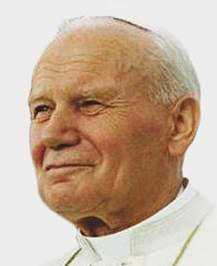

.jpg)
.jpg)
